Aston Villa have been looking like a completely different team following Unai Emery’s arrival at Villa Park shortly before the World Cup. Since Emery’s appointment, Villa have been the third-best team in the league based on points won, with only Manchester City and Arsenal having earned more points. The contrast between the current side and Steven Gerrard’s Aston Villa could not be greater.
The Spaniard is well known for his rigid defensive setups and reliability in building play out from the back, following a successful season at Villarreal in which he managed to lead them all the way to the semi-finals of the UEFA Champions League. The success and quality of performances show that Emery has a strong system in place — and one that possibly can guide Aston Villa to future success.
In this tactical analysis, Aston Villa’s tactics will be thoroughly investigated to understand how they have so quickly become one of the top teams in the Premier League. Furthermore, we will conduct an analysis of their principles in and out of possession, as well as a brief scout report on the key players and what is required from key roles in Unai Emery’s system.
Build Up
During the build-up phase, Emery encourages his side to be patient and brave, although gives them the option to go long when the option of a direct pass is on. Ollie Watkins has the physical ability to hold the ball up or chase balls played in behind, acting as an outlet, as well as the technical ability to bring the ball down, to either take on the defender or involve his teammates in the play.
Their 4-4-2 shape remains similar, with the two central defenders and two holding midfielders maintaining a box shape for effective ball progression. The two full-backs remain wide, offering a release pass from areas under pressure centrally, whilst the front four remain high, pinning the defensive line back.
In the image below, we can see the structure used to retain and progress the ball by playing out from the back. The ball-side holding midfielder starts in the opposition’s cover shadow, where the pass is cut off, but attackers cannot see where the player moves.
As the pressure comes, Douglas Luiz then attempts to move out of the shadow by shifting to the side, to enable the progressive pass. If the pressure prevents the ball-side midfielder from receiving, the far-side midfielder, Leander Dendoncker in this case, is available for a wall pass, where he can receive and find Luiz with a first-time pass.
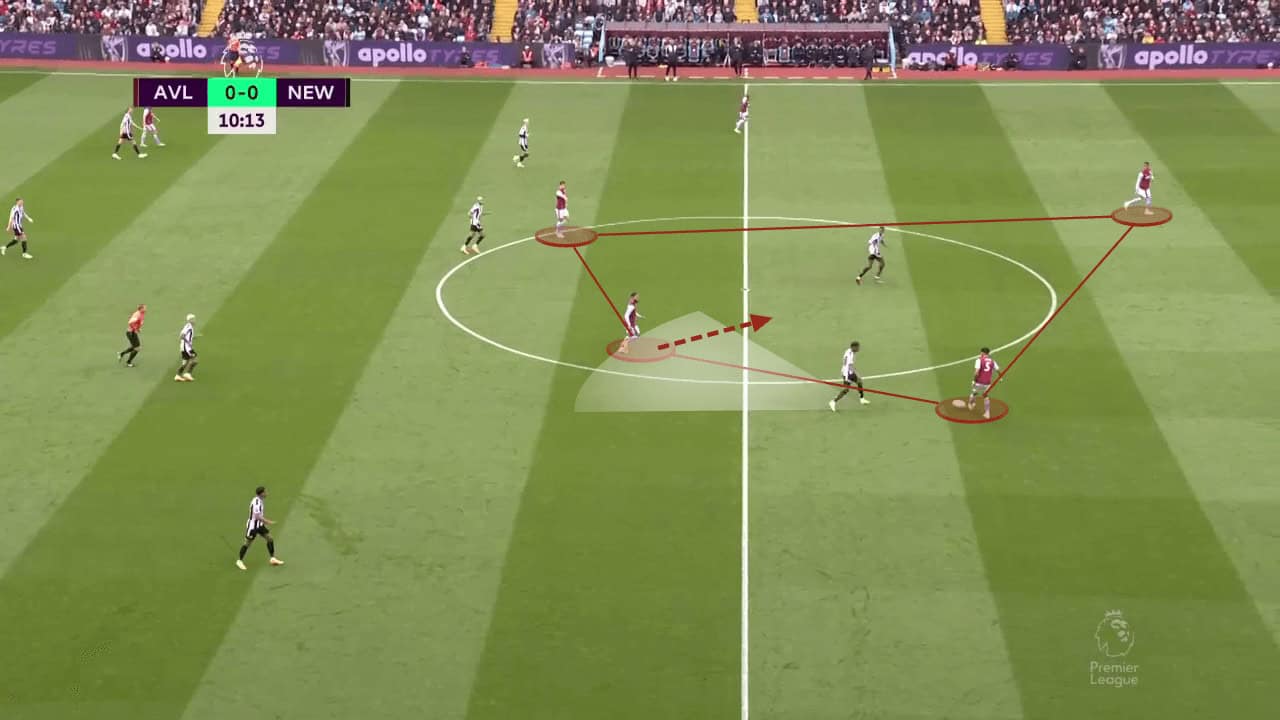
In deep areas, Aston Villa’s patient build-up attracts opposition pressure, which creates space between the opposition midfield and defensive lines, further up the pitch. The back four and holding midfielders support the ball, giving the goalkeeper as many as six potential passing options, which leaves a front four up by the halfway line, forcing the opposition’s back line to hold their position. Aston Villa attempt to have an equal number of attackers in the front line as the number of defenders in the last line, in order to create 1v1 situations which favour the attacker when so much space is available in behind.
As a result, massive amounts of space are created between the two groups of players. The black area highlights the amount of space between Villa’s back six and front four.
In these instances, Aston Villa make use of their wide players dropping deep and inside the pitch, in order to receive the ball in space and progress it from midfield areas.
The two wide positions used by Emery are best filled in by more attack-minded natural midfielders. Although starting in a front four, these players often drop into midfield positions, from where their vision, passing range and decision-making are the most important skills in progressing the ball to the front line quickly. The wide players are often tasked with dropping deep into more central areas, thus the lesser need for natural wide players starting in these positions.
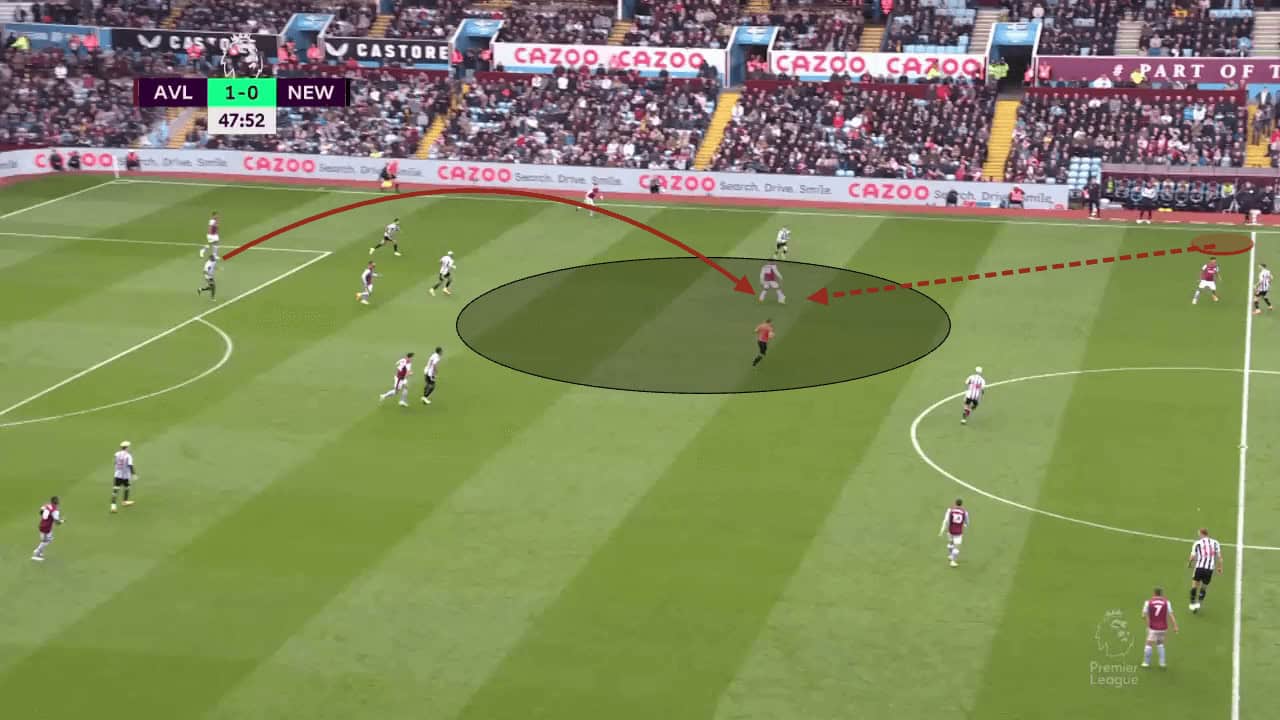
The wide player’s decision to drop deeper is often made when one of the defensive players steps up to help form the press. With the extra opponent pressing in the build-up phase, the winger dropping deep is often a release valve, allowing the Villa defenders to play a slightly more direct pass to break out of the press. Villa are still able to enjoy 1v1s across the front line, and so can afford to allow an attacking player to drop deeper whilst still carrying the dangerous threat of a direct pass to the last line.
Central defenders are less likely to be willing to step out of their position to follow the spare man in pressing situations. With the added risk of vacating central spaces, defenders usually hold their positions in the backline.
Unai Emery allows his team to make the most of these situations through the use of their forwards dropping deep to create numerical overloads in deeper central zones. The player that usually performs this role is the partner to Watkins, which has been Buendia on most occasions. Watkins’ physical presence and potential to run in behind means he is always on the last line, ready to attack balls in behind.
The image below shows Buendia starting in a higher spot before dropping deeper to collect the ball from Tyrone Mings to receive the ball and release the ball into one of the forward players. Starting in a higher position allows Buendia to be less likely to be tracked by an opposition midfielder, increasing the chance he receives the ball with time and space.
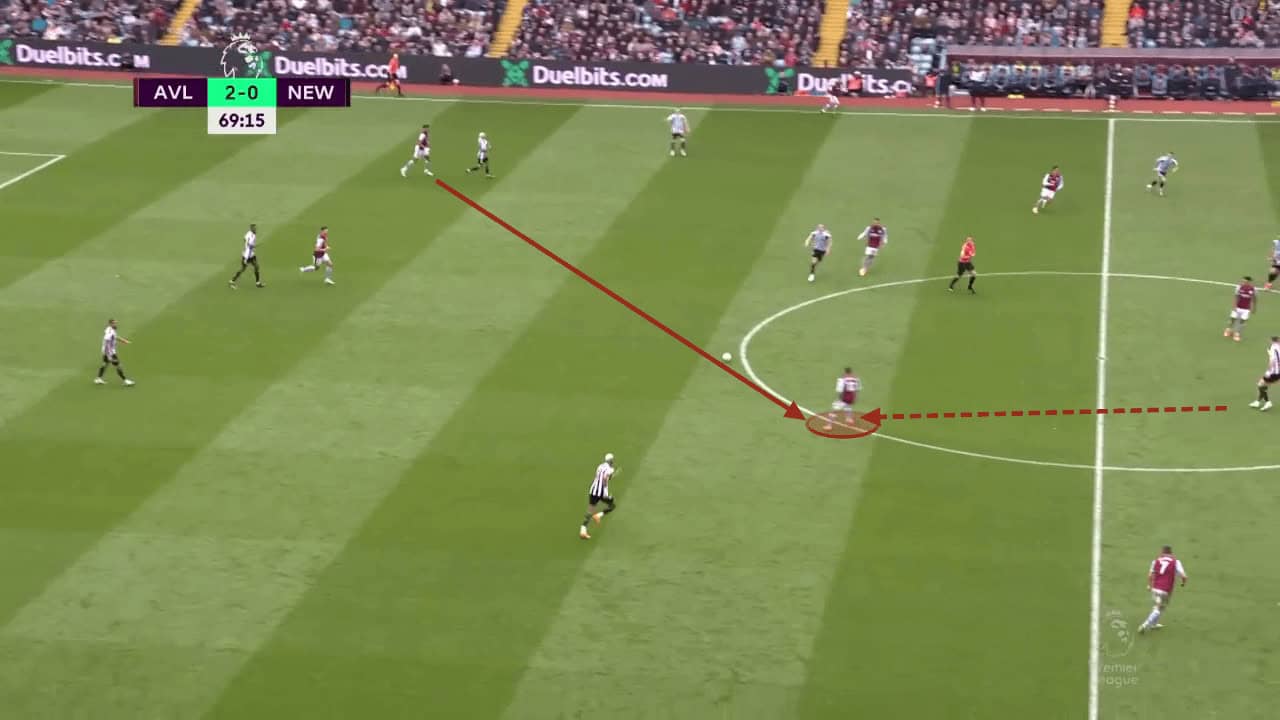
The use of a winger dropping deeper to aid the build-up also helps to increase Villa’s ability to exploit the space in behind high defences. When the opposing full-back follows his marker, to prevent the player from receiving the ball and turning on it, a space is created in the opposition’s back four.
Ollie Watkins’ best trait is his ability to run the channels, where he can make the most of his running power and ball-carrying ability to bring the ball into the box, where he can take on his defender before taking a shot on goal. Aston Villa have been able to provide Watkins with these kinds of chances on a regular basis, through the use of wide players dropping deep, which has made the most of the English forward’s strengths.
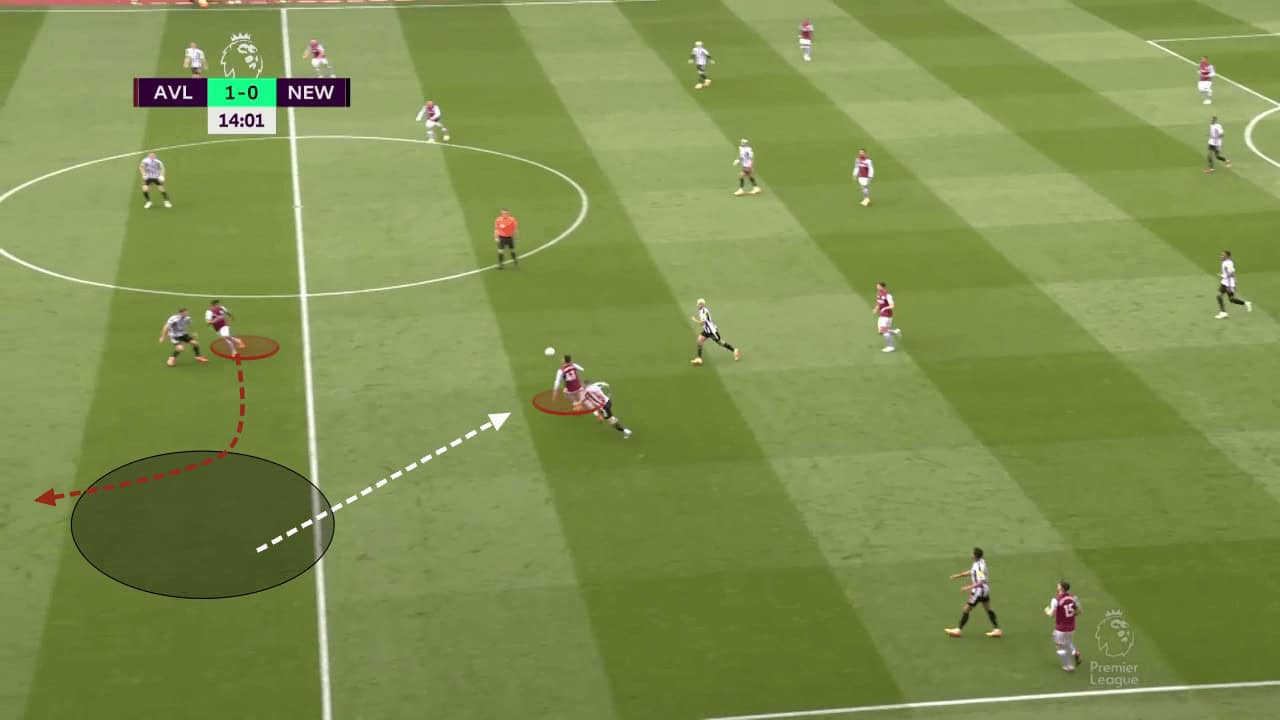
Progressing Through Narrow Positioning
Aston Villa have utilised a 2-4-3-1 system after retaining settled possession of the ball. The two central defenders and holding midfielders form the box shape as mentioned before, whilst the two full-backs hold the width, ready to make overlapping runs from deep. The two wide midfielders and one forward all drop deeper into central positions, where they can receive the ball between the lines whilst Ollie Watkins occupies the two central defenders with the potential of attacking the space behind the back line.
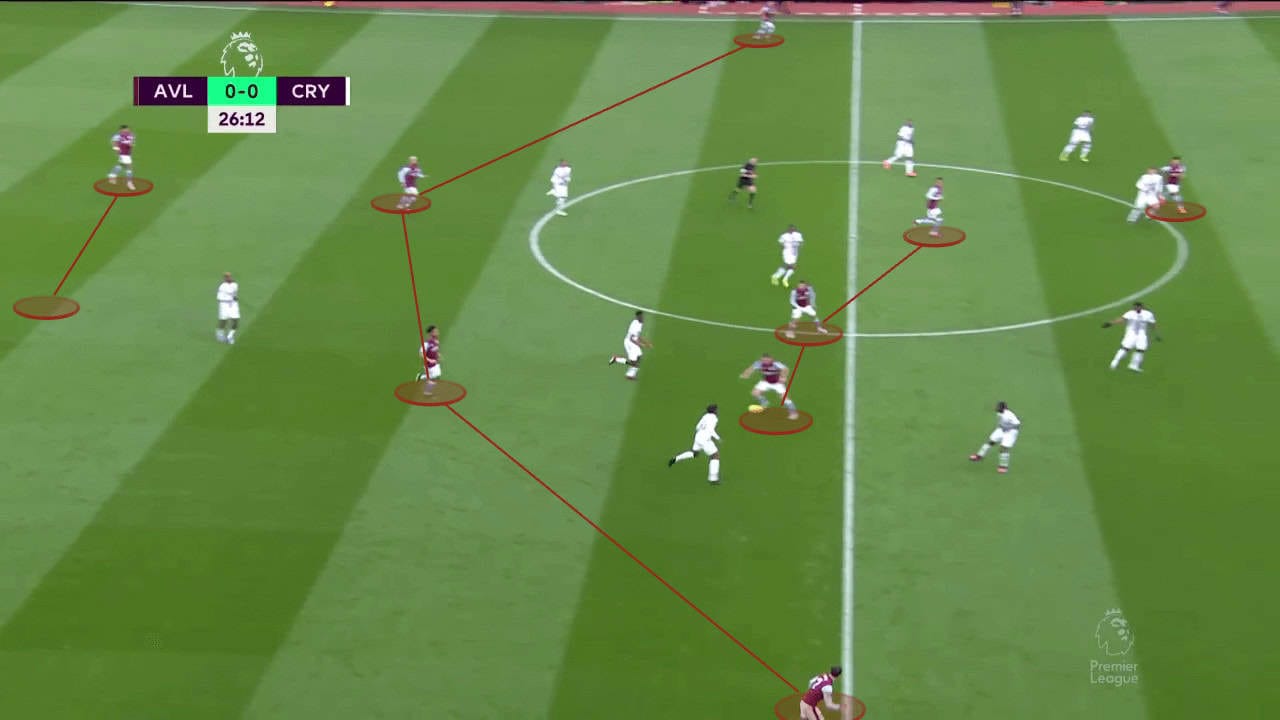
The triple occupation in zones between the lines, combined with the box rest defence and centre forward occupying the central defenders, means that Aston Villa use a very narrow shape in attack. The entire team, apart from both full-backs are all located within the width of the 18-yard box horizontally, meaning that teams have to be extremely narrow when defending, to protect against central passing combinations between the multiple attackers all in close proximity to each other.
The narrow back line, shown in the diagram below, leaves huge spaces in wide areas that Villa attempt to exploit through overlapping runs from their full-backs. The deeper starting positions of the full-backs mean that they can build up their sprinting speed so that by the time the attacking player can turn on the ball, the overlapping full-back, Matty Cash in this case, is at a higher speed when the ball is released, allowing the pass to be received closer to goal. Following Matty Cash’s injury and Ashley Young’s inclusion into the side, Villa have lost a certain amount of dynamism, which has made this slightly less effective although Young’s reliability on the ball allows them to be more efficient in the build-up.
If the opposition full-back stayed wider to prevent this, the central spaces between each defender would be exposed by the four narrow attackers.
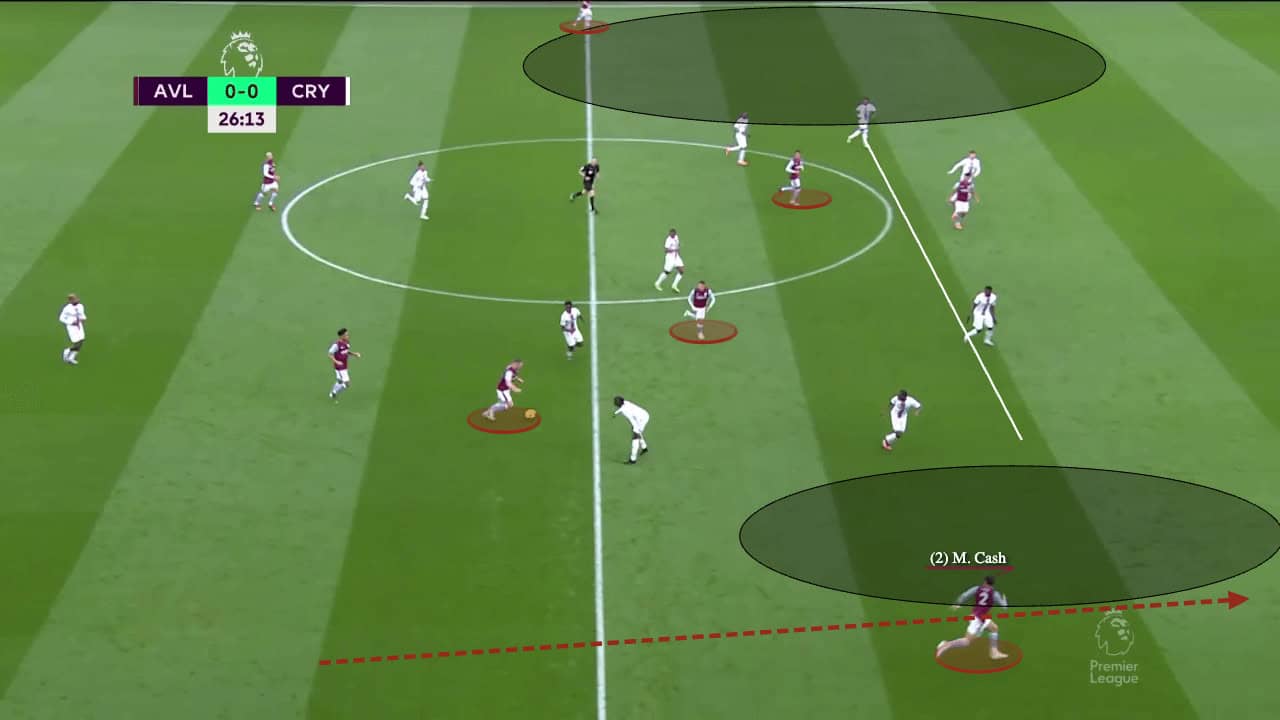
The map below displays every progressive pass Aston Villa have made in the past two months, with the patterns mentioned earlier clearly emerging. The arrows from central defenders are often received further up in wider areas, by either wingers dropping deeper or advancing full-backs.
The majority of progressive passes originate in the half-space just inside the opposition half. These are the passes made by players who receive the ball between the lines, with the triple occupation of these zones mentioned above. The passes are then often made forward into the wide areas, for overlapping full-backs to receive and deliver crosses into.
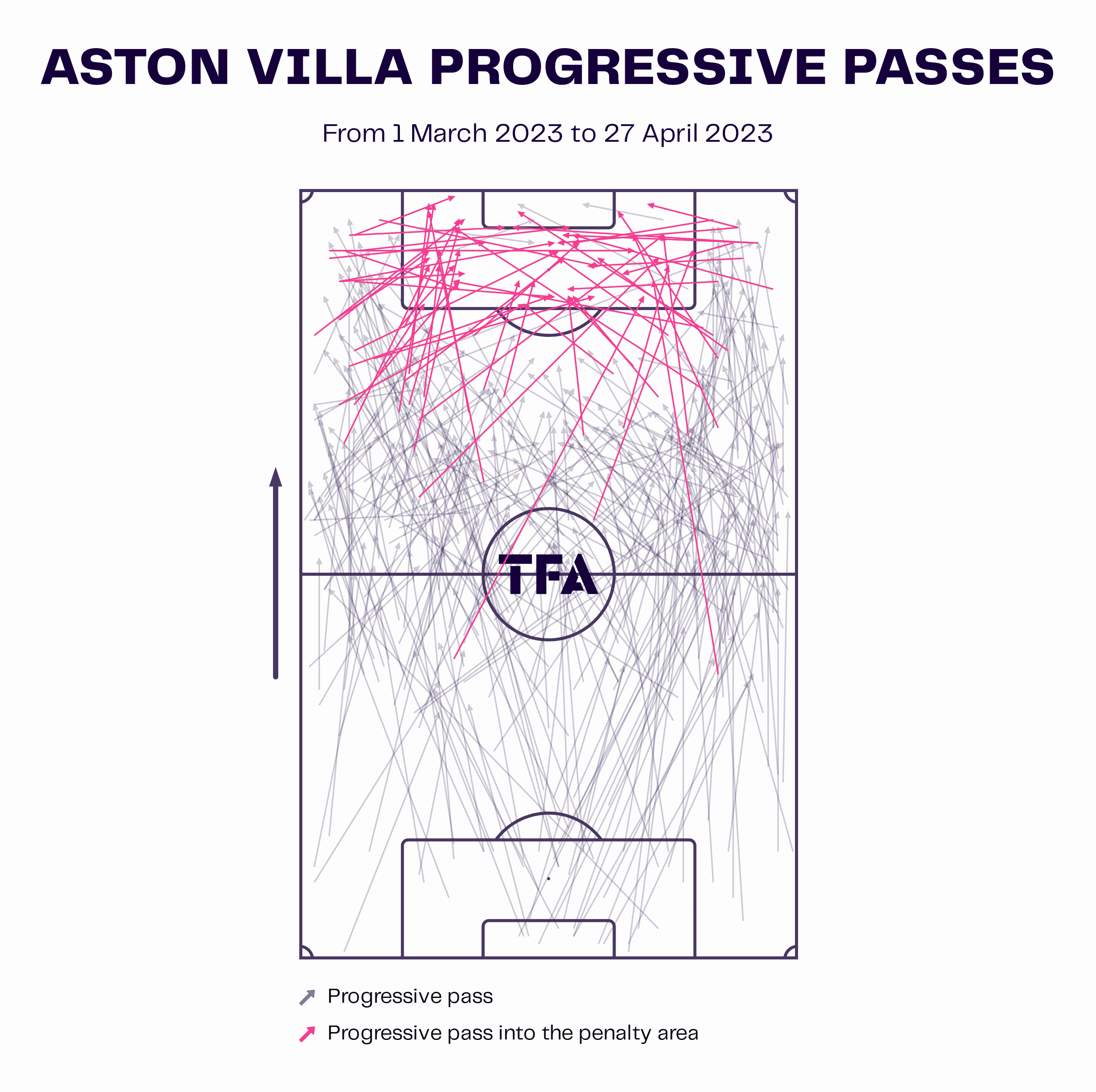
With the full-backs crossing the ball into the box, Aston Villa can attack the box with greater numbers, including the front four and far side full-back crashing into the box. Below, we can see how Watkins causes chaos by attacking the space behind the defensive lines, whilst the deeper players who are between the lines arrive late into the box to get onto the end of cutbacks or rebounded efforts.
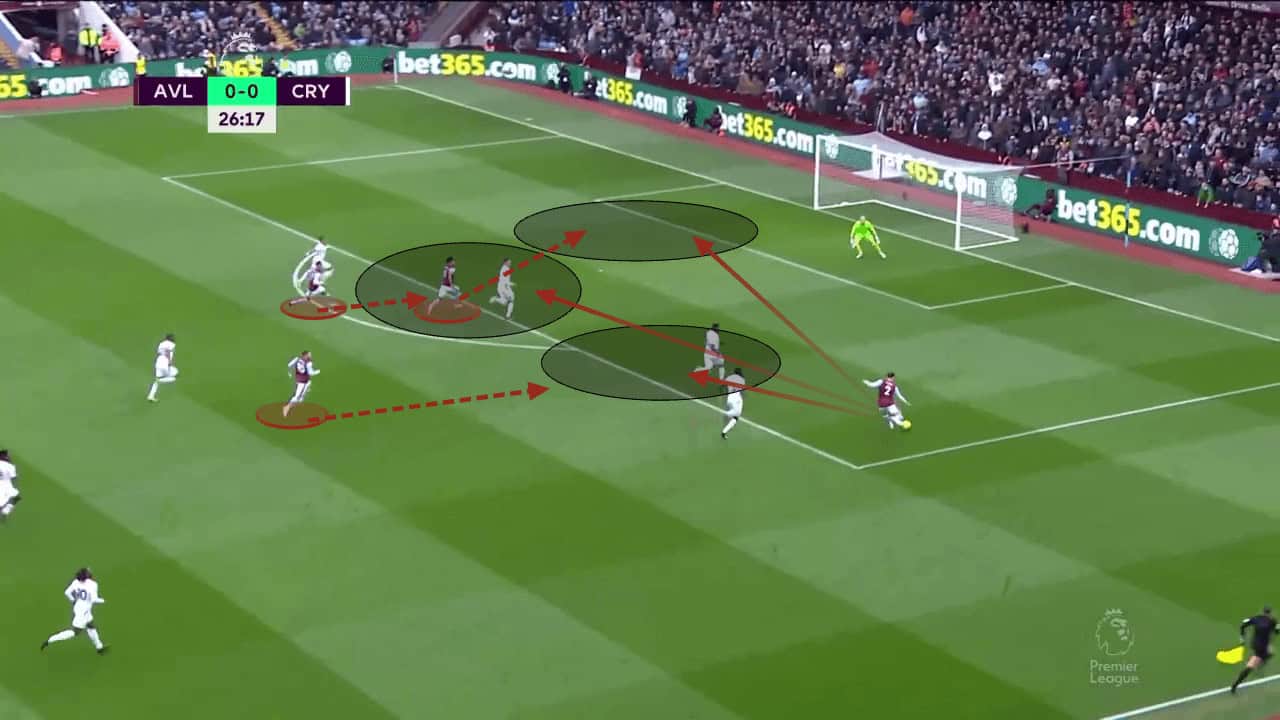
Defensive Rigidity
Although not consistently, Aston Villa attempt to press the opposition high up in their third. This is often following dead ball situations, where each player has more time to correctly move into the required position. One of the two forwards forces play to one side, whilst the other forward forces the central defender to go into the wide areas.
The winger matches up with the full-back, whilst the central midfielders man-mark passing options in the middle of the pitch. The far-side winger covers the middle of the pitch to track any potential players dropping deep to receive the ball. The diagram below illustrates how this process happens, with the intent to win the ball back high up in the opposition’s third and lead to a direct scoring opportunity.
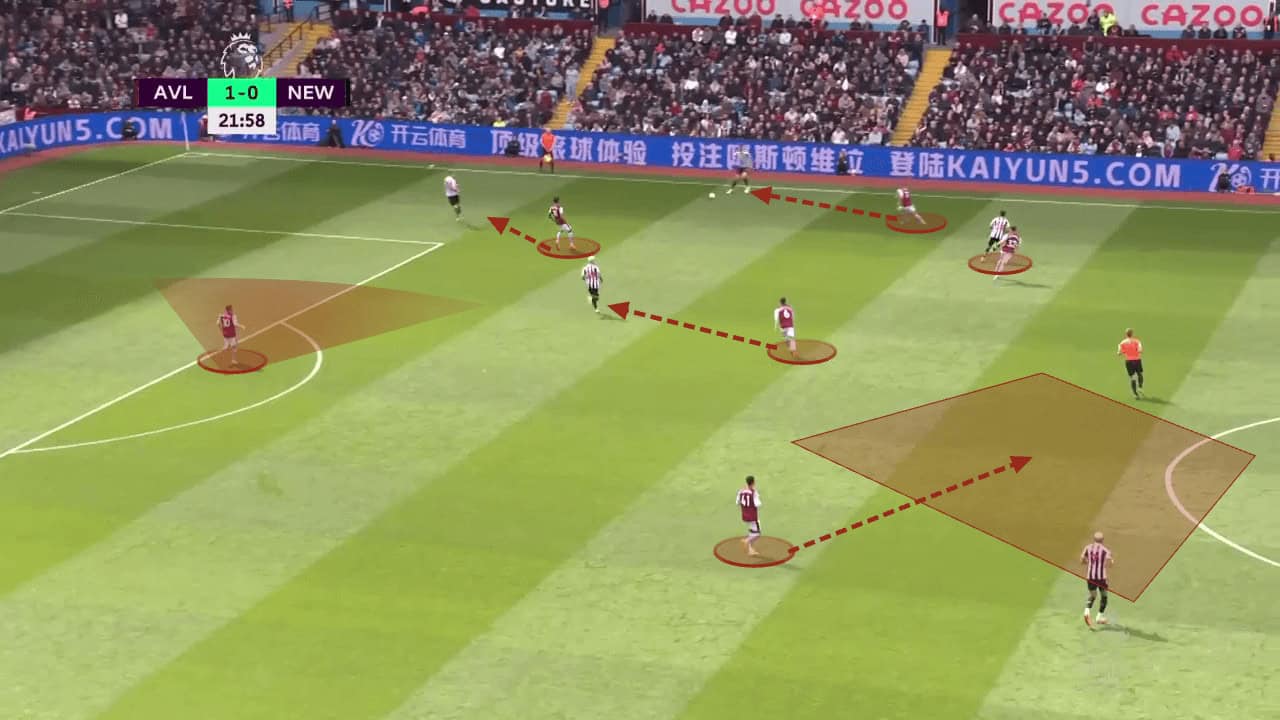
When the ball is in settled play, Villa often resort to their compact 4-4-2 mid-block, where opponents are forced to play around or over the block. Aston Villa maintain a high line, although it can be penetrated if the pressure from the front isn’t aggressive enough, allowing attackers the play the perfect pass.
The image below shows the vertical compactness, with hardly any space between the defensive and midfield line, meaning players can’t receive the ball in tight central spaces with time to turn and attack the defence. The two forwards rotate to pressure the ball player and pivot player, in order to force opponents to play down either flank.
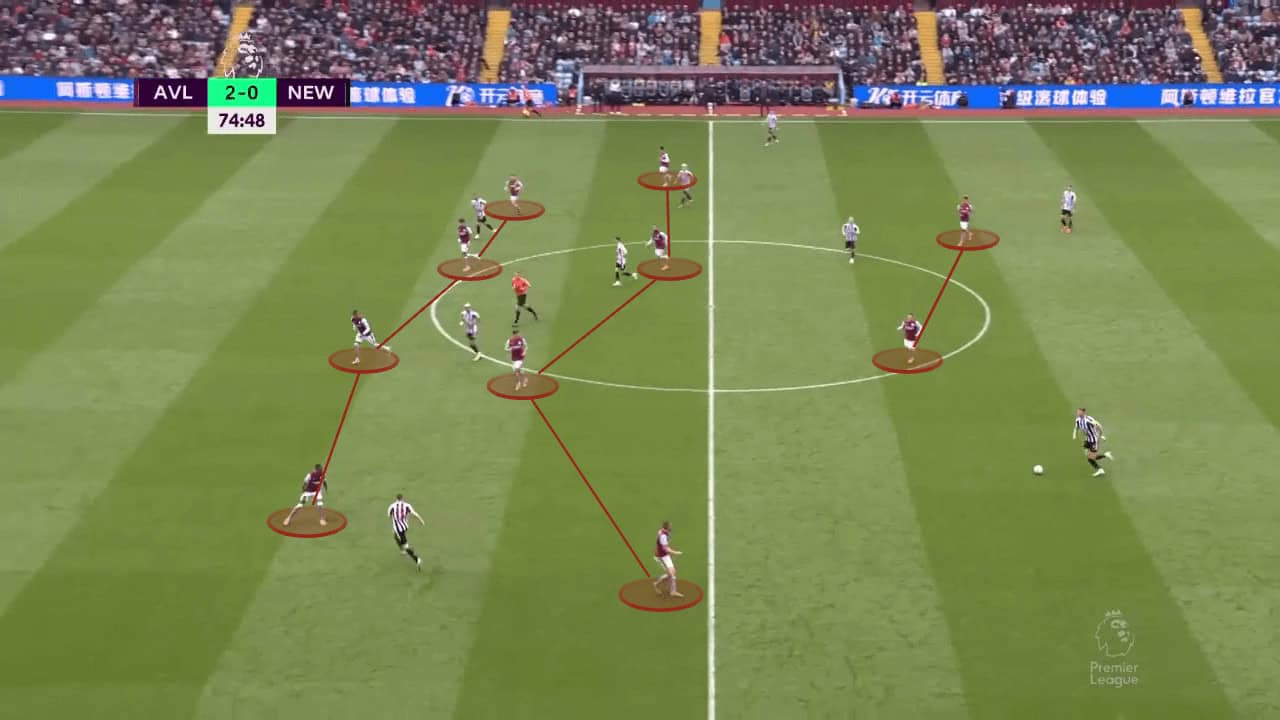
Part of what has made Aston Villa such a difficult team to beat is their use of a 6-2-2 low block to see out results. Aston Villa utilise the extra numbers in the defensive line in order to protect themselves from any direct balls into the box by almost always being guaranteed to have a spare defender to help clean up any difficult situations. The two wide players drop into the last line, preventing opposition teams from having numerical superiorities in the wide areas.
The use of a box midfield in front of the back 6 allows Aston Villa to protect the zone outside of the box. The near-side midfielder helps to track any runs from deep into the penalty box, with the far-side central midfielder always providing cover in central zones. The front two for the Villans helps prevent opposition teams from sustaining complete control, by having the chance to counterattack with two players located high, who can combine with each other to start counterattacks.
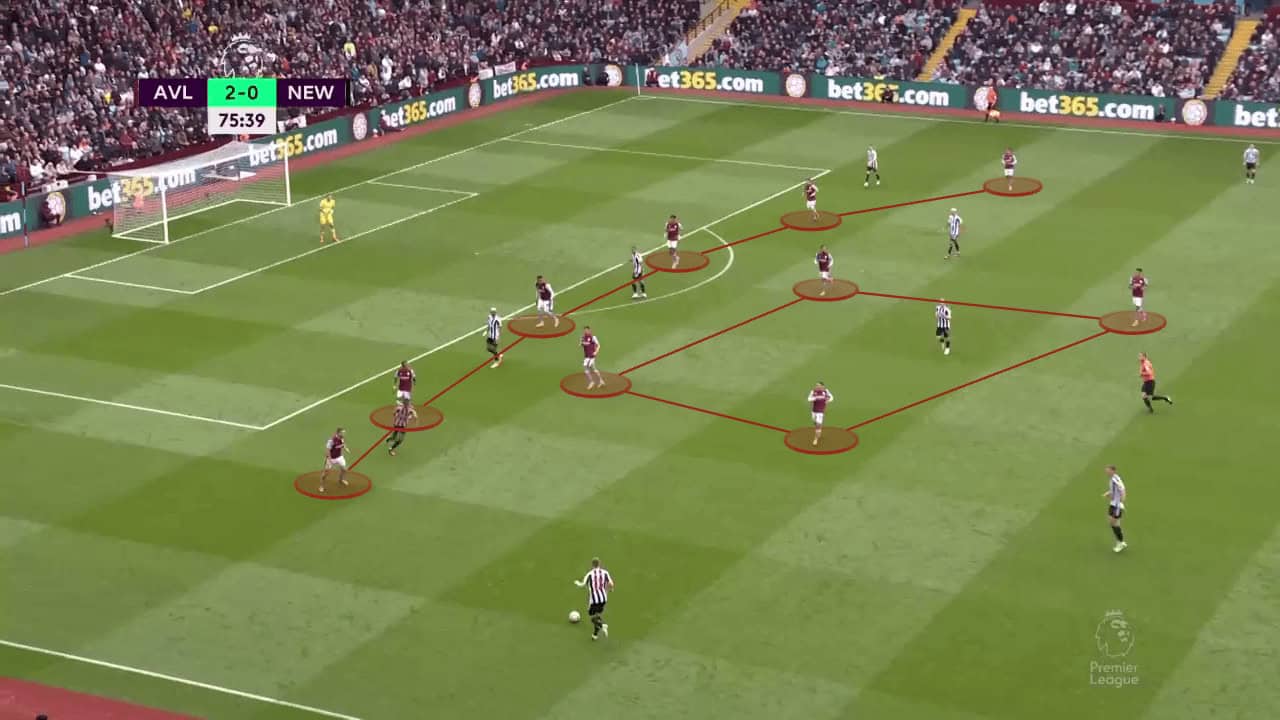
Summary
Unai Emery has provided Aston Villa with a set of clear tactical instructions, ones which can be followed quite simply and provide an effective and consistent method of gaining points. There is no luck behind their incredible form under the Spaniard, and Unai Emery has shown his complete knowledge of his system by making two bold decisions in the January transfer window.
The decision to sell Danny Ings when Watkins wasn’t in a streak of form or without much depth in that position shows just how much Emery trusted his ability in coaching a settled build-up which will provide Watkins with numerous opportunities to run in behind. Although Ings is a quality player, he has a different set of strengths to Watkins, and Emery instantly knew Watkins suited the system to a tee.
The signing of Alex Moreno also displays how Emery already has the tools in his mind to succeed. The full-back for Aston Villa needs to have creative abilities, which although Digne possesses with his passing range, he lacks in his dribbling ability. Alex Moreno has shown the ability to be isolated in wide areas at times, where he has dribbled his way into the box to provide chances for teammates with excellent crosses into the box.
A European campaign seems to be on the table for next season, and with Emery already being confident in the tactical details of his system, the next signings made by Emery should also smoothly fit in to avoid any more wasteful transfers that may have been made in the past few seasons. Villa will likely have a healthy budget to work with, which will allow Emery to maximise the effectiveness of his system.






Comments